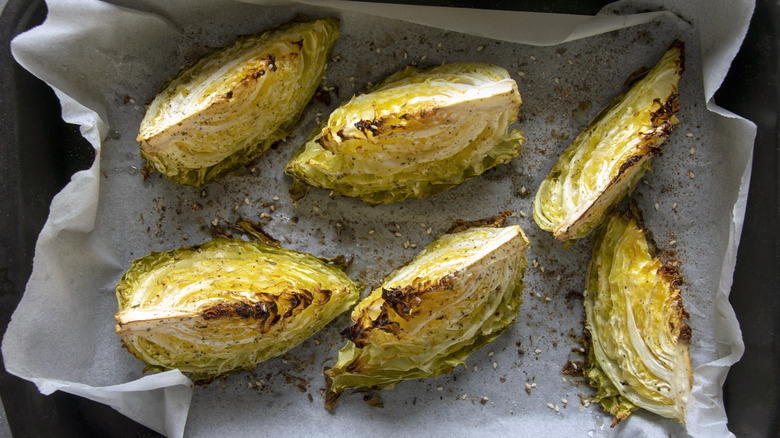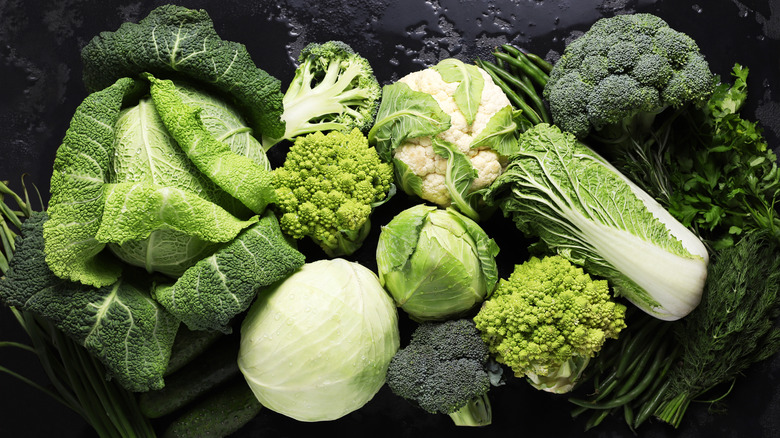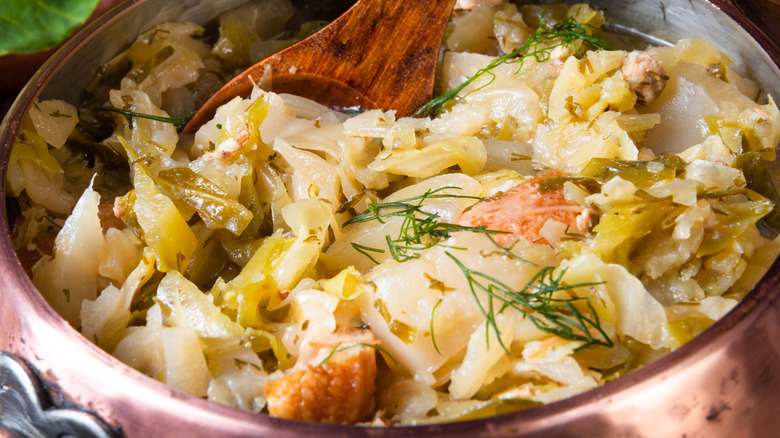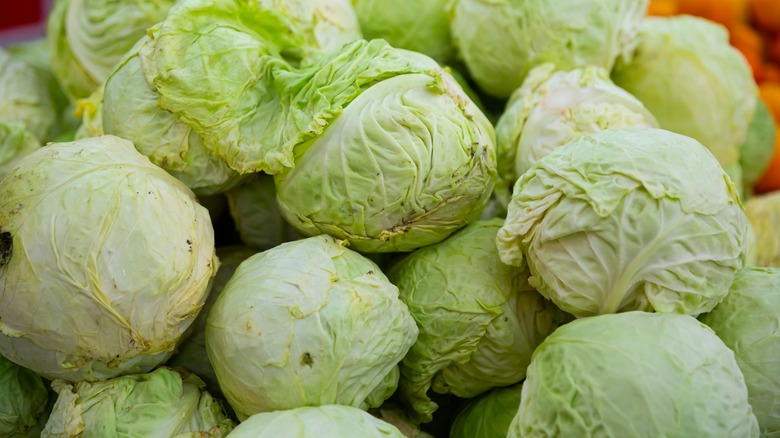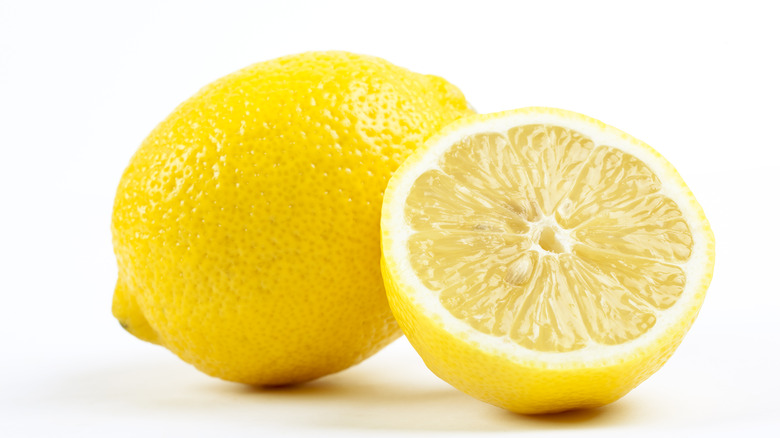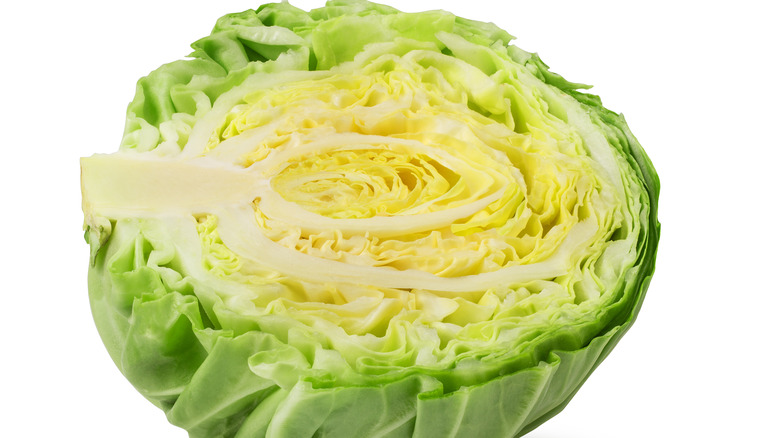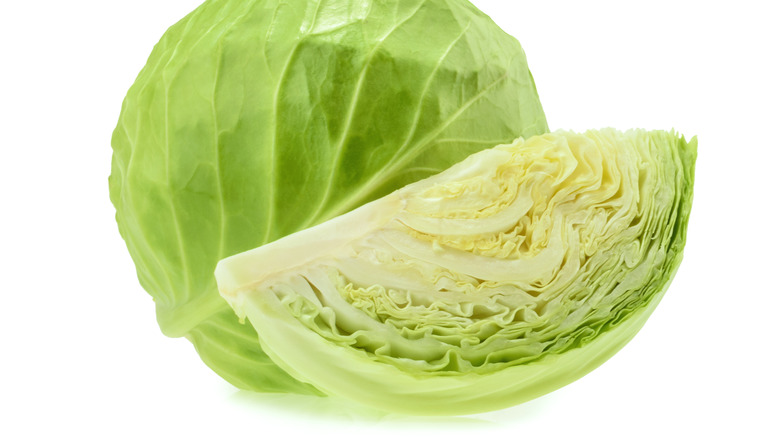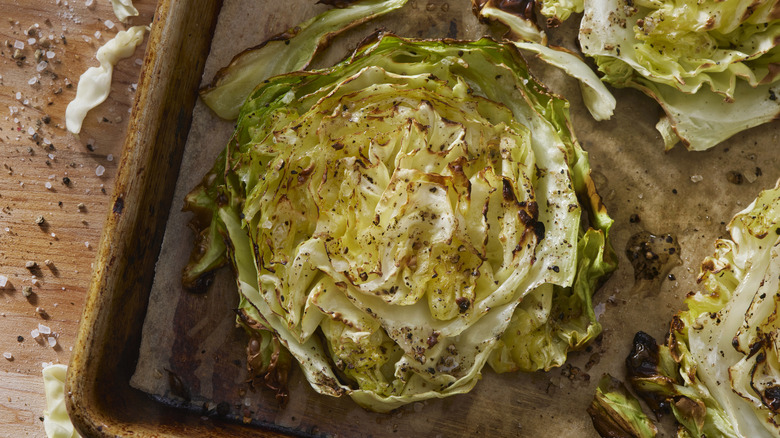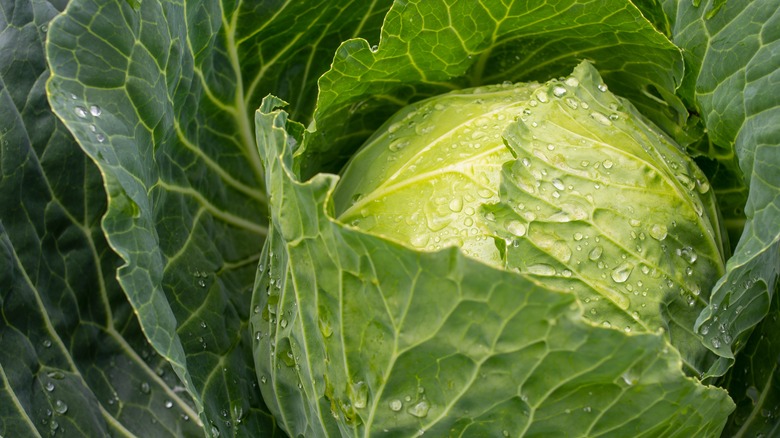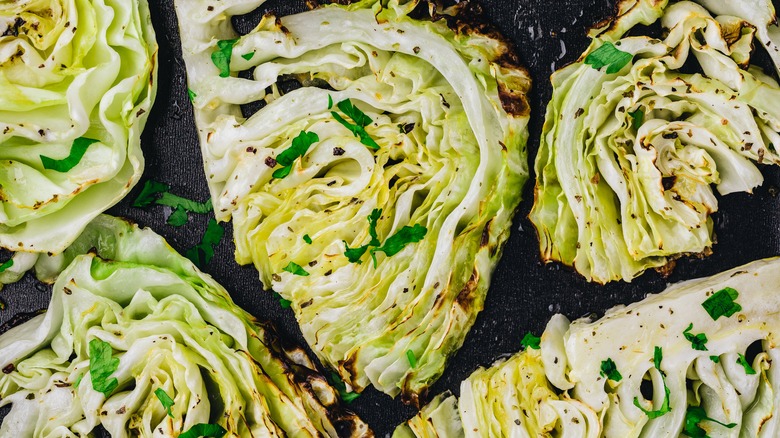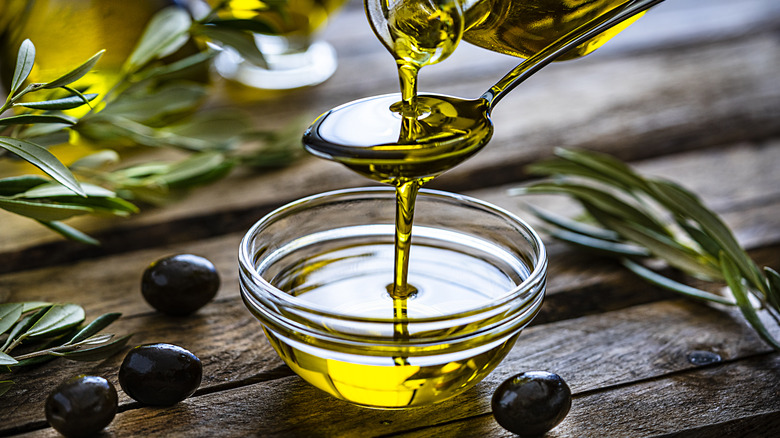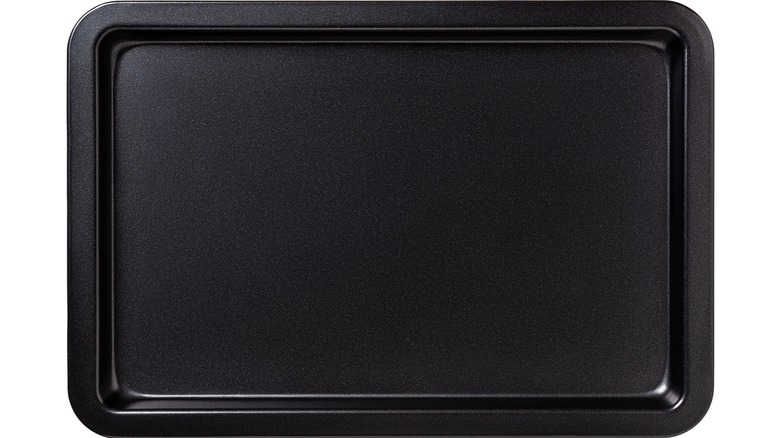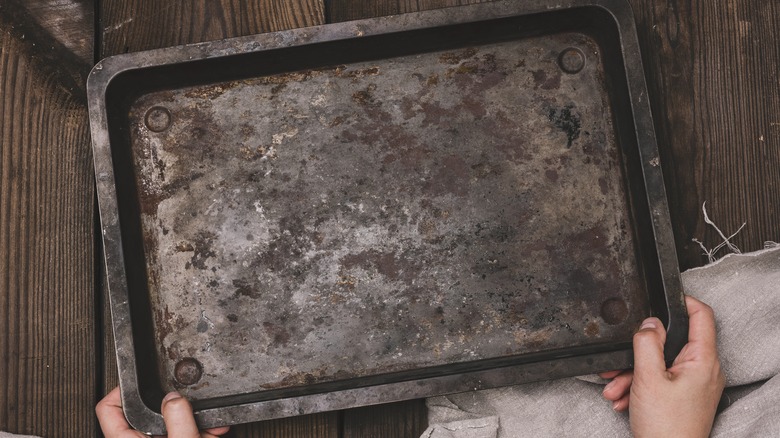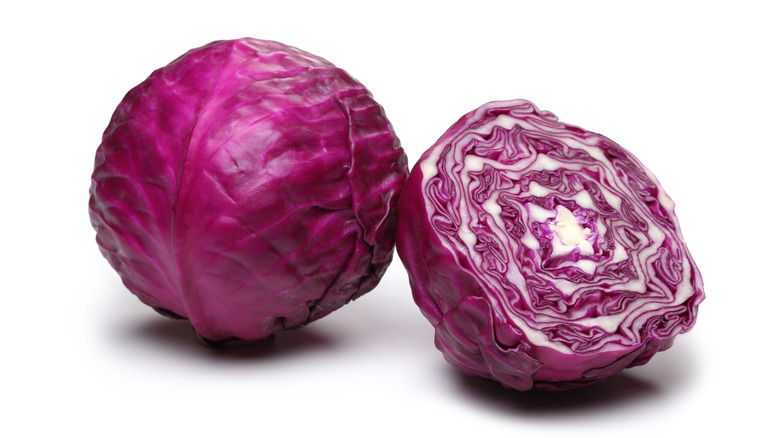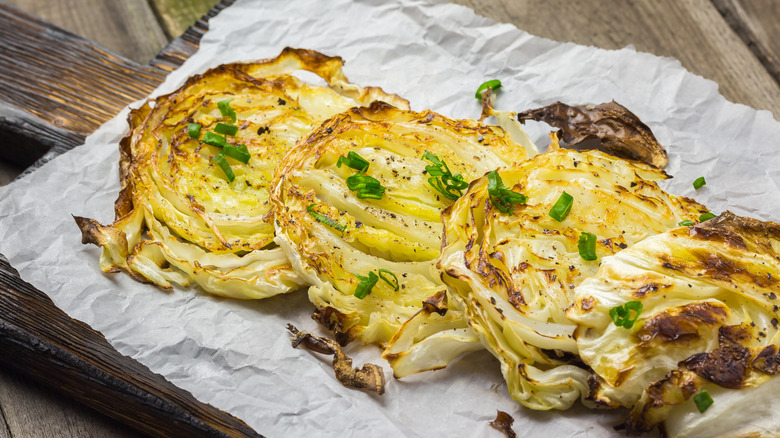14 Tips You Need For Roasting Cabbage
Kale might have gotten all the love in recent years, but there's one cruciferous vegetable that deserves more praise. It's cabbage, the budget-friendly kitchen staple you should always have close to hand if you enjoy bitter greens. We love having cabbage on hand because it's so incredibly versatile. You can eat it raw, either on its own or in slaws. But there are so many other ways to cook cabbage. It can be fried, sautéd, or grilled over an open flame.
However, if you want to capture its leafy deliciousness in all its glory, you may want to try roasting your cabbage. Roasting brings out a sweeter flavor in your cabbage, which makes it palatable even for those who generally don't enjoy eating a lot of greens.
That being said, it's easy to mess up roasted cabbage, especially if it's an ingredient you're not familiar with cooking. That's why we want to share some helpful cabbage-roasting tips to ensure your wintertime vegetable cooking experiments go to plan.
Remember that not all cabbages roast equally
If you want to make the perfect roast cabbage, start at the grocery store, farmer's market, or wherever you usually buy produce. That's because not every cabbage roasts the same way, and some varieties are better for roasting than others. For the best results when roasting cabbage, ensure you buy the right type of cabbage. Luckily, the kinds that roast well are the ones that are generally the easiest to find: green and red cabbage. They're heavy, round, and widely available at many supermarkets across the country.
However, there are some types of cabbages to avoid roasting if you're looking for the best possible outcome. Savoy and napa cabbages, for example, probably won't take to the oven as well as green and red cabbages. This is because they have thinner, more delicate leaves that wilt easier in the oven. That means they're easy to burn, which is probably not what you're going for when making roasted cabbage. Red and green cabbages, though, have thicker, sturdier leaves that can hold up to this cooking method better than their more delicate counterparts.
Cook your cabbage with bacon
Some people dislike the flavor of cabbage. They think it's bitter and unappetizing, especially when served on its own. Of course, for some people, the flavor profile is never quite right and we can't blame them for staying away from a veggie they don't like. However, for many of us, cabbage can be made more appetizing by adding ingredients that change its flavor and even its texture. There is, perhaps, no ingredient that transforms cabbage as well as bacon.
When you add bacon to your roasted cabbage, you'll be left with a heartier, more filling dish. All that fat helps the cabbage crisp up nicely, and pairing cabbage with bacon can make the rich, hearty meat feel more digestible. It's a combo you can never go wrong with. You can add bacon to the pan your cabbage is roasting in, or you can cook your bacon separately on the stove and combine the two ingredients later.
Aim to undercook your cabbage, never overcook it
One problem that far too many of us experience when we're cooking cabbage is the dreaded mush. You've been there before, cooking the tough, crunchy leaves to make them easier to chew and swallow. But spend just a few minutes too long cooking your cabbage, and you're left with a mushy mess. It's something you probably want to avoid when planning dinner, so it's best to keep a close eye on the cabbage you're roasting.
Instead of setting a timer and letting the oven do its work, make sure you check on your cabbage often. To keep it from getting too soggy, you may want to aim for undercooking, rather than overcooking, the veg. Remember, you can always give it more time in the oven, but there's no fixing cabbage once it's too mushy.
In time, you'll learn how best to roast your cabbage so it always comes out with the kind of texture you're looking for. Until then, avoid overcooking by regularly checking your cabbage.
Brighten the dish with a lemon sauce
Cabbage is earthy, bitter, and complex. It's a flavor you don't get from many foods, which is one reason why it's among our all-time favorite vegetables. But just because it has an interesting flavor on its own doesn't mean it can't benefit from being paired with other flavorful ingredients. If you're looking for something that will give your roasted cabbage a new flavor profile, try making roasted cabbage with lemon sauce.
You won't need many ingredients (or even a ton of cooking skills) to make a delicious lemon sauce for your roasted cabbage. All you need to hand is some lemon juice, along with butter or oil, garlic, and other seasonings like crushed red pepper, cayenne, or even some cumin. These few ingredients will add a layer of complexity to the dish you can't achieve with roasted cabbage alone. When all these flavors come together, you get a richer, more complex dish that pairs well with meat, beans, and tofu. Give it a try next time you roast a cabbage.
Make sure you keep the core intact
If you've ever roasted a cabbage before and had the cabbage fall apart on you in the oven, you're not alone. Cabbage can be a tricky vegetable to work with because it's just a bunch of leaves folded against each other. If those leaves come apart, it's easy to burn the individual leaves, resulting in a mess in your oven. Pretty much everyone who's ever roasted cabbage before has run into this problem (and hopefully has caught it before the fire alarm goes off).
So, how do you prevent your cabbage from falling apart and burning to a crisp in your oven? It's easy. Just make sure you keep the core intact when roasting your cabbage. Instead of cutting out the core and throwing it away, cut through the cabbage, keeping the core in the center of the vegetable. That core will keep all the leaves from falling away from each other, preventing the individual leaves from burning.
Cut your cabbage into large pieces to maximize surface area
When you look at a recipe for roasted cabbage, you may notice that the directions say you should core your cabbage. But that may not be in your best interests. We've already talked about how keeping the core of your cabbage intact can help prevent it from falling apart and burning individual leaves, but it can also help you achieve a crispier texture and a more complex flavor.
Why is keeping the core intact the best way to roast a cabbage? Well, a lot of it comes down to the amount of surface area that's exposed to heat. When you expose more of a cabbage's surface area to the pan, the parts that touch the pan will turn brown and crispy, which is what you're looking for in a roasted cabbage. At the same time, the inside of the cabbage will become soft and caramelized, creating a wonderful textural contrast.
Try cabbage steaks for an easy-to-eat version of the vegetable
Most of the time, when you roast a cabbage, you probably cut the vegetable into wedges. This seems to be the most common way of cooking the veg, and it generally yields delicious results. But it's not the only way of preparing a cabbage. If you're looking for an alternative, you might want to try cooking cabbage steaks. Instead of cutting your cabbage into wedges, cut it into round "steaks" instead.
Cutting your cabbage this way allows both sides of the "steak" to brown and caramelize perfectly, which means everyone at the table gets a super-crispy piece of cabbage. But it can also just be an easier way to eat cabbage. When you cut it like this, you can dig into it just like a regular steak. Whether you're looking for a vegan alternative to a meat-heavy meal or you're trying to prepare familiar foods in new ways, making roasted cabbage steaks can be a fun dish to try.
Remember to find a use for the outer cabbage leaves
Before you roast a cabbage, the vegetable requires a little prep work. Not only will you want to wash the cabbage, but you should also remove the outer leaves. These leaves are usually tougher than the tender leaves inside, and they may be covered with dirt or bruises. But just because you're removing them from the cabbage doesn't mean you can't find a way to use them. By utilizing these leftovers, you can cut down on food waste in the kitchen.
There are quite a few ways to use the outer cabbage leaves. You could make stuffed cabbage with them for an appetizer, or you could turn them into kimchi or sauerkraut. These outer leaves are also great for making slaws to put on sandwiches or to enjoy on their own. If you don't want to use the leaves for any of these purposes, you can also chop them up and add them to a soup for some added greens, nutrition, and flavor.
Roast at a high heat to highlight cabbage's sweet flavors
Have you tried to roast cabbage over and over, only to repeatedly get a mushy, soggy mess? It's a problem that's common for people new to roasting cabbage. There could be a few different issues at play, but there's a good chance the problem is temperature. You probably don't want to burn your cabbage, so you may hesitate to turn the heat on your oven up too high. Actually, you'll want to use high heat to roast your cabbage. When you do, it will help highlight the cabbage's slightly sweet and almost nutty flavor profile, which is more appealing than the bitter, watery flavor cabbage can have when raw.
And when we say "high heat," we mean it. If you're roasting a cabbage, set your oven to 500 degrees Fahrenheit. You may have to keep a closer eye on the roasting cabbage to ensure it doesn't burn, but the crispy, browned results are worth the extra effort.
Use oil and seasoning for more flavor
Admittedly, cabbage has a lot of flavor on its own, so you may assume there's not much you need to do with it besides roasting to harness the best flavors in the vegetable. That's not entirely true, though. Plain cabbage is fine, but it's so much better when flavored with other ingredients. Firstly, you'll want to use plenty of oil when roasting your cabbage. This will help brown the exposed parts of the cabbage, giving you that crispy texture and slight crunch you're going for, but it'll also help season the cabbage — after all, fat makes just about everything taste better.
And you can't forget about seasonings, either. Andrew Zimmern's roasted cabbage recipe calls simply for salt and pepper, and that's really all you need to make a delicious side dish. However, you could add even more flavor to the mix by utilizing ingredients like paprika, white pepper, cumin, or some cayenne for a bit of heat. Don't be afraid to experiment with different seasonings.
Use a sheet pan, not parchment paper
Everyone who uses their oven a lot is aware that roasting anything can make for a big mess, particularly if it sticks to the pan you're working with. Once you're done cooking, you must let that pan soak sometimes for hours, which can be a hassle if you want to clean up quickly after dinner. Therefore, some of us turn to parchment paper to cut down on the cleanup time we have to contend with. When it comes to roasting cabbage, though, using parchment paper is not a good idea.
Will lining the pan with parchment paper make cleaning it slightly easier? Sure. But it will also prevent the cabbage from making contact with the metal pan. That's not ideal because contact with the pan helps your cabbage wedges (or steaks) crisp up nicely. Without touching the hot metal, your cabbage won't get the same crispy, browned texture you're probably going for.
So, what exactly should you roast your cabbage on? Your best bet is to opt for a dark sheet pan, which will capture plenty of heat and help roast your cabbage to perfection.
Preheat your pan
You're probably used to preheating your oven when baking cookies or broiling a cheesy casserole. But it may not occur to you to preheat the pan you're using. Most of us turn on the oven and put the pan in when it's up to temperature and ready to go. You may get better results if you preheat your pan, though. Heating the pan ahead of time allows the cabbage to start cooking more quickly, which gives you even more flavorful caramelization on the exterior of the vegetable.
Luckily, preheating the pan is a simple step that requires no additional work. When you start preheating your oven, place your chosen pan inside as it comes up to temperature. Once the oven is ready to use, take the pan out and place the cabbage, cut side down, on top of it. Pop it back in the oven, and you'll have gorgeously crispy roasted cabbage in no time.
Consider using red cabbage for crispier results
When most of us think of roasted cabbage, we think of green cabbage. It does seem to be the standard for most roast cabbage recipes, which makes sense when you consider how easy it is to find at grocery stores. But just because green cabbage may be the conventional choice doesn't mean it's the only option to consider when roasting a cabbage. Instead of always opting for green cabbage, why not give the red variety a try?
Red cabbage can be even easier to roast than the green stuff because it doesn't contain as much water and tends to be denser than its green counterpart. This will help you achieve crispier results with less heat. Plus, it'll offer a slightly different flavor than what you're used to with green cabbage: Red cabbage tends to have a stronger, more peppery flavor. If you're looking for a way to switch up your veggie game, try roasting a red cabbage.
Make sure you don't overcrowd your baking sheet
It's a bummer to roast any vegetable to have it come out soggy and wet when you want it dry and crispy. That can be a big problem with cabbage, which can turn mushy if you're not careful. One thing you definitely shouldn't do if you want to ensure that you're roasting your cabbage correctly is overcrowd the pan. This is a common problem that many home cooks have experienced. If you put too much on a pan at one time, you're not going to get roasted cabbage — you're going to get steamed cabbage. This is because the water from the vegetable will get trapped between the pieces of cabbage. Since it can't escape, it makes the cabbage all soft and mushy.
Therefore, you should ensure there's plenty of room between the cabbage wedges or steaks on your pan. You may have to use another pan to avoid this steaming problem. Although that may result in a few more dishes to wash up, it's worth it to get the crispy texture you're going for.
